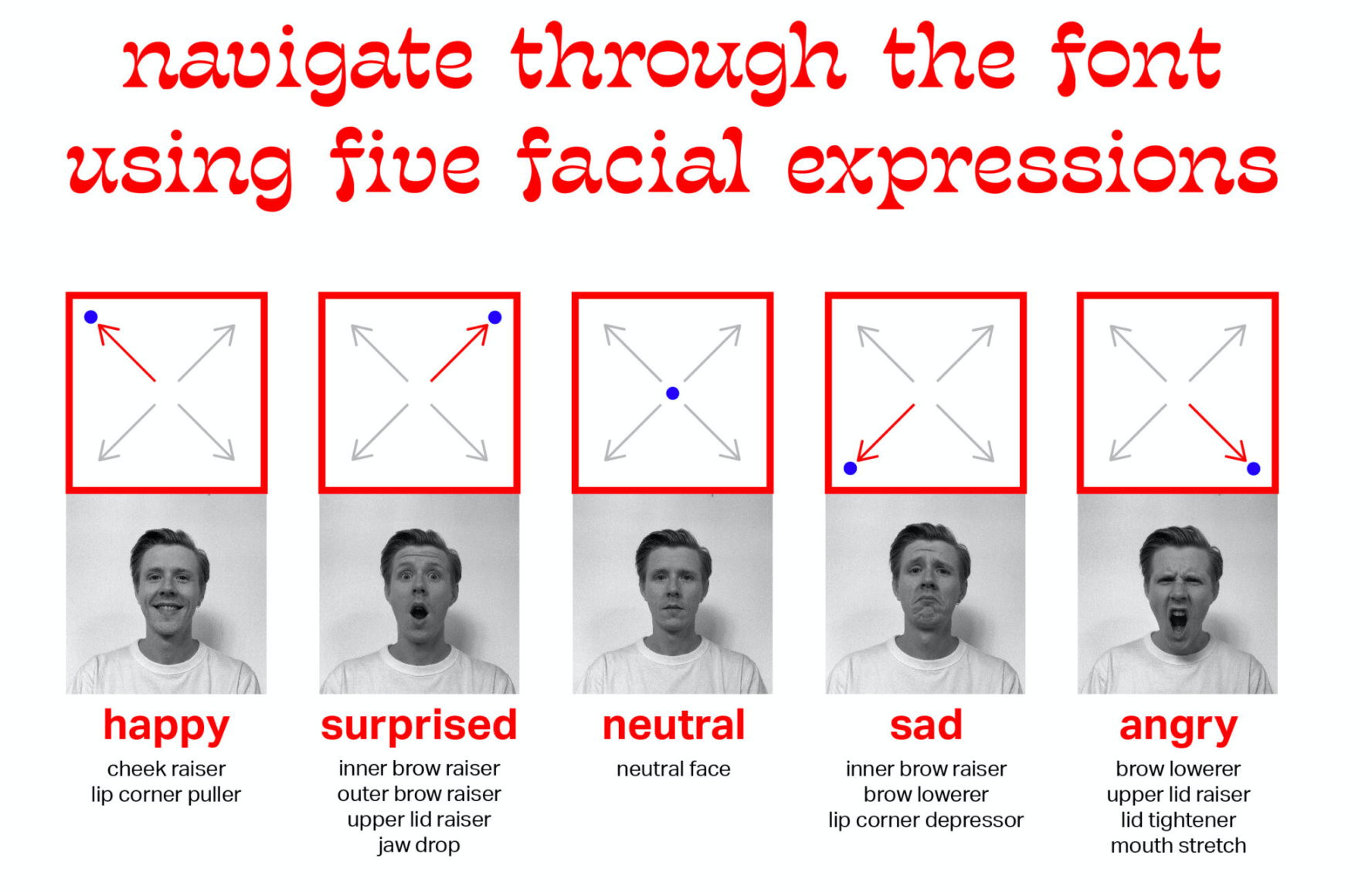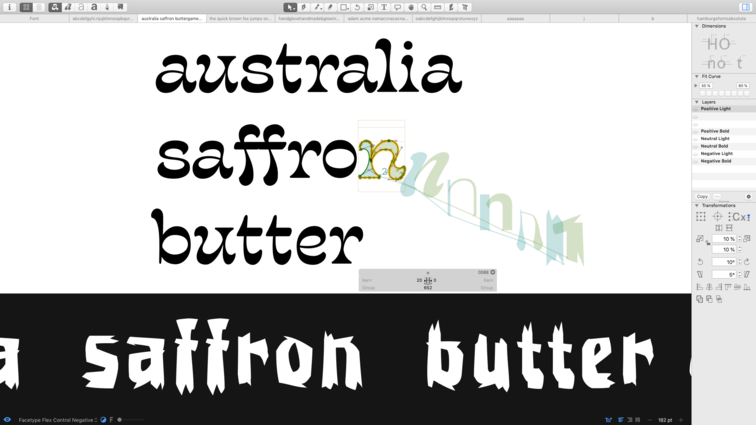臉部細微表情識別
原型 (The prototype)
Facetype is the name of Adam’s interactive project, in which the emotions detected from a person’s facial gestures control a variable font. To each detected emotion corresponds a specific typeface, which keeps transforming as your facial expression changes in front of the camera. This project does, in fact, link a variable font with face-api.js, an open-source AI that can detect and measure facial expressions in real-time.
Facetype是Adam互動項目的名稱,其中從一個人的面部手勢檢測到的情緒控制著可變字體。 每個檢測到的情緒都對應一個特定的字體,當您的面部表情在鏡頭前改變時,該字體會不斷變化。 實際上,該項目確實將可變字體與可以實時檢測和測量面部表情的開源AI face-api.js鏈接。

The font contains five different, but continuous, styles that attempt to represent visually five different facial gestures: happy, surprised, neutral, sad, and angry. Before associating each emotion to each specific style in this project, Adam spent time researching how people react to and perceive different typefaces, analyzing what emotions are evoked when presented with a specific typeface.
字體包含五個不同但連續的樣式,這些樣式試圖在視覺上代表五個不同的面部手勢:快樂,驚訝,中立,悲傷和憤怒。 在將每種情感與每種特定風格相關聯之前,Adam花了一些時間研究人們對不同字體的React和感知方式,分析了呈現特定字體時會引起哪些情感。


The gestural interface created by Adam allows you to explore each typeface and style of the font only using your facial expressions. The cursors on the red and blue quadrants move in synch; the first indicates the registered facial gesture and the second shows the corresponding type.
Adam創建的手勢界面允許您僅使用面部表情來瀏覽字體的每種字體和樣式。 紅色和藍色象限上的光標同步移動。 第一個表示已注冊的面部手勢,第二個表示相應的類型。

Today we communicate so much with text. And when we do so, we remove all non-verbal communicators and rely on a static copy of the spoken language. In real life, facial expressions are visual signals used to modify or reinforce verbal communication and to establish empathy with the interlocutor.
今天,我們通過文字進行了很多交流。 并且,當我們這樣做時,我們將刪除所有非語言交流者,并依賴口頭語言的靜態副本。 在現實生活中,面部表情是一種視覺信號,用于修改或加強語言交流并與對話者建立同理心。
Emoji represent a way to communicate emotions graphically and in a more emphatic way. Many emoji are in fact used to emulate the facial expression we would have while saying the things we are typing. But the font of text can’t be edited based on our mood or the emotions we feel. Adam’s prototype allows us to communicate with a personal typeface, where written words reflect the sender’s expression. Will variable fonts be integrated in our keyboards in the future, exactly like emoji, GIFs and stickers are integrated in the keyboards we use today?
表情符號代表一種以圖形方式和更強調方式傳達情感的方式。 實際上,許多表情符號用于模仿我們在說輸入內容時所具有的面部表情。 但是無法根據我們的心情或感覺來編輯文本的字體。 亞當的原型使我們能夠使用個人字體進行通信,其中書面文字反映了發件人的表情。 將來會在我們的鍵盤中集成可變字體嗎,就像我們今天使用的鍵盤中集成了emoji表情 ,GIF和貼紙一樣嗎?
什么是新的 (What’s new)
Variable fonts aren’t new. Dalton Maag has been experimenting with them for a couple of years already. In an interview we did with Bruno Maag last year, he claimed that variable fonts are one of the latest innovations in the type industry and that Dalton Maag are investing in them. He stated, “variable fonts have great potential, but their future is dependent on how people use them”.
可變字體不是新的。 道爾頓·馬格(Dalton Maag )已經嘗試了兩年。 在去年與Bruno Maag進行的一次采訪中 ,他聲稱可變字體是字體工業中的最新創新之一,而Dalton Maag也在對此進行投資。 他說:“可變字體具有巨大的潛力,但它們的未來取決于人們如何使用它們”。

What Adam did with variable fonts is something new: he used them in an interactive way, with an open-source AI.
亞當使用可變字體所做的事情是新的:他通過開源AI以交互方式使用它們。
Connecting inputs and outputs in new, unexpected, ways is something that Danish creative coder, Andreas Refsgaard, is famous for; he uses algorithms and machine learning to create unconventional connections between inputs and outputs. For example, he has worked on projects that allow people to play music using only eye movement and facial gestures, or to control games by making silly sounds (discover more). He also created an online bookstore selling sci-fi novels where everything —the stories, book covers, reviews, and prices — is entirely generated by AI.
丹麥創意編碼員Andreas Refsgaard以新穎,出乎意料的方式連接輸入和輸出而聞名。 他使用算法和機器學習在輸入和輸出之間創建非常規的連接。 例如,他參與了一些項目,這些項目允許人們僅使用眼睛的移動和面部手勢來播放音樂,或者通過發出愚蠢的聲音來控制游戲( 發現更多信息 )。 他還創建了一家在線書店,出售科幻小說 ,其中的所有內容(故事,書的封面,評論和價格)完全由AI生成。
Adam, in this project, ideated his own unconventional connection between input and output: he combined creative coding with type design.
在該項目中,Adam提出了自己的輸入與輸出之間的非常規聯系:他將創意編碼與字體設計結合在一起。
We are looking forward to seeing the possibilities that this experiment will open up in the future, since this might change the way we communicate. The way in which this prototype might come into use is yet to be explored!
我們期待看到該實驗將來會開放的可能性,因為這可能會改變我們的交流方式。 該原型的使用方式尚待探索!
關于亞當 (About Adam)
Originally from Australia, Adam Lenzinger recently graduated in Graphic Communication Design from The Royal Danish Academy of Fine Arts, where he is now research assistant. With his project Facetype, he was one of the finalists of the Danish Design Award 2020 in the category “Young Talent”.
Adam Lenzinger最初來自澳大利亞,最近畢業于丹麥皇家美術學院圖形通信設計專業,現在是研究助理。 通過他的項目Facetype,他 是2020年丹麥設計獎“青年才藝”類別的決賽選手之一。


Design Matters 20將于2020年9月23日至24日回到哥本哈根。令人驚嘆的數字設計師陣容將分享他們關于數字設計新動向的故事。 (Design Matters 20 is back in Copenhagen, on Sep 23–24, 2020. An amazing cast of digital designers will share their stories on new movements in digital design.)
翻譯自: https://medium.com/demagsign/can-you-control-a-typeface-using-only-your-facial-expressions-61c43ee2d71f
臉部細微表情識別
本文來自互聯網用戶投稿,該文觀點僅代表作者本人,不代表本站立場。本站僅提供信息存儲空間服務,不擁有所有權,不承擔相關法律責任。 如若轉載,請注明出處:http://www.pswp.cn/news/274363.shtml 繁體地址,請注明出處:http://hk.pswp.cn/news/274363.shtml 英文地址,請注明出處:http://en.pswp.cn/news/274363.shtml
如若內容造成侵權/違法違規/事實不符,請聯系多彩編程網進行投訴反饋email:809451989@qq.com,一經查實,立即刪除!


















